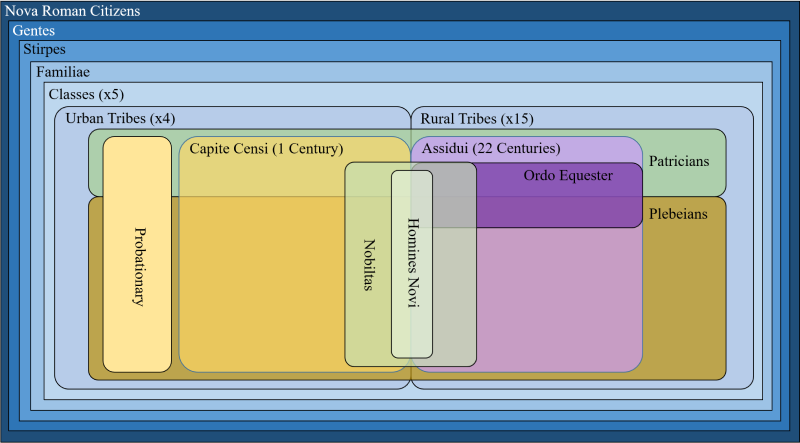Society of Nova Roma
Home | Latíné | Deutsch | Español | Français | Italiano | Magyar | Português | Română | Русский | English
⚜⚜⚜ Site Index - Key Pages ⚜⚜⚜
Modeled accurately on ancient Roman social structures, there are various groups, categories and levels in Nova Roman society depending on the point of view of analysis.
|
Patricians and plebeians
Nova Roman citizens are either patricians or plebeians. Based on the family's time of establishment in Nova Roma, this division serves mostly ceremonial and religious purposes. Patricians aren't considered "superior", only primordial and more suited to religious service, while plebeians have certain political rights and privileges that patricians don't.
Equestrians
The ordo equester (equestrian order) is the order of the highest standing Nova Roman citizens, the equites (knights). The knights are the elite of the Nova Roman citizenry, who excel in their service and contributions to our republic. Registered merchants of Nova Roma can also become members of the equestrian order. Learn more...
Nobiles and "new men"
A nobilis is a member of a Nova Roman family, indicated by a nomen-cognomen combination that revives an ancient Roman family where the ancestors held curule magistracies. A homo novus is a citizen who would be the first in his family to hold a curule magistracy.
Assidui and capite censi
An assiduus is a taxpayer citizen of Nova Roma who has at least 16 census points, a member of the Nova Roman social elite, a privilege open to all citizens who are dedicated enough to pay the small amount of "tax" (membership fee) of Nova Roma. Assiduus citizens are distributed into the 31 rural tribes (against the 4 urban tribes of the capite censi) and into the 30 centuries of the 5 classes (against the 1 single century of the capite censi). These instructions ensure that assidui have an overwhelming voting weight in all comitia, but specially in the comitia centuriata. Capite census (or alternatively called proletarius) citizens represent the lowest, "outclassed" mass of a Roman society, which in Nova Roma consists of people who are not dedicated enough to contribute financially to the cause of Nova Roma by paying a small amount of membership fee, and it includes those taxpayers, too, who haven't yet collected enough census points with their activities. |
Classes
There are 5 classes in Nova Roma into which all centuries are distributed with the citizens placed therein based on census points and taxpayment. The 1st class is the highest, containing the top citizens. The higher the class, the more centuries it contains, consequently, the more voting weight it has. Learn more...
Centuries
Centuries are voting blocks of the comitia centuriata. Every citizen of Nova Roma is placed into a century determined by two factors: taxpayment and census points. The current number of centuries is 31. Out of these 31 centuries, 30 are reserved for assiduus citizens, the elite of the citizenry, and 1 is reserved for the capite censi, the masses of inactive citizens. Learn more...
Tribes
Tribes are voting blocks of the comitia populi tributa and comitia plebis tributa. Every citizen of Nova Roma is placed into a tribe, determined by taxpayment. The number of tribes is 35. Out of these 35 tribes, 31, called "rural tribes", are reserved for assiduus citizens, the elite of the citizenry, and 4, called the "urban tribes" are reserved for the capite censi, the masses of inactive citizens. A citizen's placement within a tribe is partially dependent on tax payments made, but also on the citizen's voting participation in our main election. Learn more...
Census points
Census points are service points or merit points given for serving the res publica of Nova Roma in elected or appointed offices and for length of citizenship. The role of these points is to determine the social status (called "one's census" by the Romans) of each citizen in the Nova Roman society. In ancient Rome, this role was assigned to money and wealth as Rome was a plutocracy, and social status was determined by wealth. In Nova Roma, social status is determined by public service and activity, by contribution to the society. This makes Nova Roma a "meritocracy". Learn more...
|
|
Other Portals
| |
